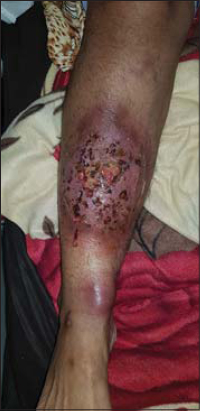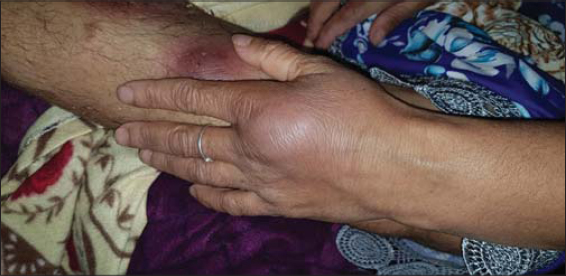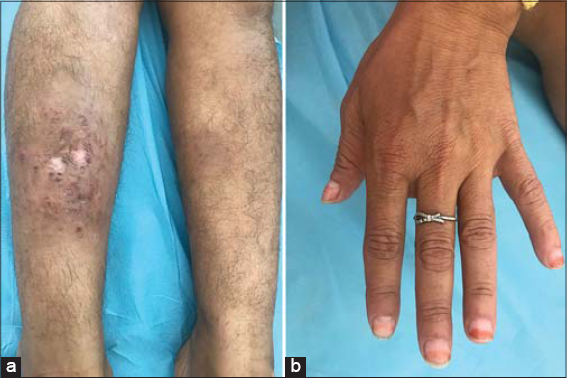Cutaneous aseptic abscesses syndrome
Selma El Kadiri , Sara Elloudi, Rhizlane Chaoui, Hanane Bay Bay, Fatima Zahra Mernissi
, Sara Elloudi, Rhizlane Chaoui, Hanane Bay Bay, Fatima Zahra Mernissi
Department of Dermatology, CHU Hassan II, Fez, Morocco
Corresponding author: Dr. Selma El Kadiri, E-mail: elkadiri-s@hotmail.com
Submission: 16.02.2020; Acceptance: 05.03.2020
DOI: 10.7241/ourd.2020e.27
Cite this article: El Kadiri S, Elloudi S, Chaoui R, Bay Bay H, Mernissi FZ. Cutaneous aseptic abscesses syndrome. Our Dermatol Online. 2020;11(e):e27.1-e27.2.
Citation tools:
Copyright information
© Our Dermatology Online 2020. No commercial re-use. See rights and permissions. Published by Our Dermatology Online.
Sir,
Clinical manifestations of inflammatory bowel diseases are polymorphous [1]. Aseptic abscesses syndrome is a rare auto-inflammatory disorder [2]. Here we report a case of previous cutaneous aseptic abscesses onset of Crhon’s disease.
A 36-year-old woman was referred to our department for 2 months cutaneous abscesses recurring after several courses antibiotics. Past medical history was unremarkable and no history suggestive of inflammatory bowel disease. She was sub febrile at 37.9°C with preserved general statement. The dermatological examination revealed inflammatory nodules on the leg, over the back side of the hand fistulized to the skin with a purulent discharge (Figs. 1 and 2). The lesions were extremely painful and disabling. The direct bacteriological examination of the liquid was sterile on several occasions. Histopathological examination of the biopsy samples showed a nonspecific inflammatory reaction with many altered neutrophils without appearance of leukocytoclasia. An abdominal ultrasound did not show the presence of intra-abdominal abscesses. Taking in consideration these recurrent inflammatory lesions despite antibiotics, the negativity of repeated microbiological samples and the dermo-hypodermic infiltrate rich in neutrophils at biopsy, the diagnosis of aseptic skin abscesses was retained. Colonoscopy revealed ulcerative colitis, without ileal or rectal involvement. The patient admitted a mucous diarrhea preceding the appearance of skin lesions. Layered colic biopsies highlighted chronic erosive and scarring colic compatible with Crohn’s disease. Treatment with oral corticosteroid therapy associated with azathioprine has healed skin and digestive lesions (Figs. 3a and 3b). No recurrence has occurred within 6 months.
Cutaneous aseptic abcesses syndrom is a rare anatomoclinical entity of unknown etiology characterized by multiple lesions rich in neutrophils [1]. The strict localization on the skin like our patient is rare [2]. It is a diagnosis of elimination after ruling out other infectious causes of the abscess. It is frequently associated with inflammatory bowel diseases (50%) but also with neutrophilic dermatosis, relapsing polychondritis and spondylarthropathies sunggesting a link with these auto-inflammatory diseases [2]. The specific treatment of cutaneous manifestations of this entity is based on corticosteroind therapy, immunomodulators and immunosuppressive agents [3]. In case of recalcitrant forms, blocking the IL-1 pathway is a possible alternative which has not been necessary in our case [4].
Consent
The examination of the patient was conducted according to the Declaration of Helsinki principles.
The authors certify that they have obtained all appropriate patient consent forms. In the form the patient(s) has/have given his/her/their consent for his/her/their images and other clinical information to be reported in the journal. The patients understand that their names and initials will not be published and due efforts will be made to conceal their identity, but anonymity cannot be guaranteed.
REFERENCES
1. Thrash B, Patel M, Shah KR, Boland CR, Menter A. Cutaneous manifestations of gastrointestinal disease:part II. J Am Acad Dermatol. 2013;68:211.
2. AndréMF, Piette JC, Kémény JL, Ninet J, Jego P, Delèvaux I, et al. Aseptic abscesses:a study of 30 patients with or without inflammatory bowel disease and review of the literature. Medicine (Baltimore). 2007;86:145-61.
3. Szwebel T-A, Casadevall M, Chosidow O, Gaucher F, Perrot S, Le Jeunne C, et al. Atypical recurrent aseptic cutaneous abscesses as the presenting manifestation of Crohn’s disease. Rev Med Interne. 2010;31:705-8.
4. Salléde Choua C, Ortonne N, Hivelinc M, Wolkensteina P. Aseptic cutaneous breast abscesses associated with ulcerative colitis. Ann Dermatol Venereol. 2016;143:139-43.
Notes
Source of Support: Nil.
Conflict of Interest: None declared.
Request permissions
If you wish to reuse any or all of this article please use the e-mail (brzezoo77@yahoo.com) to contact with publisher.
| Related Articles | Search Authors in |
|
 http://orcid.org/000-0003-3455-3810 http://orcid.org/000-0003-3455-3810 |






Comments are closed.